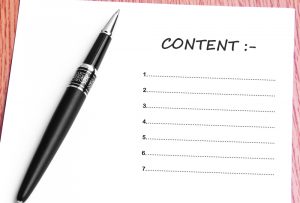What is a Contents Page in a Book?
 The contents page (table of contents) is a crucial aspect in any book. It tells the reader what to expect – how many chapters there are, what the sections of the book look like, how long it is, and what pages they can find certain topics on. The table of contents is found in the frontmatter of the book, along with the dedication and the epigraph. It may seem like a small aspect of the book, but it’s a necessary one.
The contents page (table of contents) is a crucial aspect in any book. It tells the reader what to expect – how many chapters there are, what the sections of the book look like, how long it is, and what pages they can find certain topics on. The table of contents is found in the frontmatter of the book, along with the dedication and the epigraph. It may seem like a small aspect of the book, but it’s a necessary one.
A table of contents page lists out what the book includes. This can be section topics, chapter titles, and discussions. In fiction (novels), the table of contents lists the chapter titles and the pages they’re found on. In some instances, these chapters will have creative and unique titles. In others, they may simply read “Chapter One,” “Chapter Two,” and so on.
In nonfiction books – like biographies or memoirs or historical books – chapter titles, sections, descriptions, and page numbers can be found. Descriptions for sections or chapters are more often used in textbooks, biographies, historical books, etc. In cookbooks, the contents page contains a list of meals with page numbers where the recipes can be found.
Why is a Table Of Contents Necessary?
A table of contents is important to orient the reader. It gives them a roadmap to the novel (just like a plot outline acts as a map to the writer). Breaking up writing into manageable chunks (sections, parts, chapters) makes it easier to digest for readers. Plus – if someone flips open the book to the contents page and likes the creative chapter titles, this could convince them to purchase the book!
In nonfiction books the contents page serves as a reference and makes it easier to jump around from section to section, say, if the book was being used in a classroom setting.
Designing a Table Of Contents Page
A book contents page design should be clean and simple. The text should be uniform and neat and the same as the rest of the text in the book. The reason the Table Of Contents design should be neat is that the reader should be able to easily and quickly peruse the book’s contents. When creating a table of contents, like anything else in the novel, always keep the reader in mind.
Table Of Contents Page Examples
Example from Cat’s Cradle (Fiction) by Kurt Vonnegut:
- The contents page for Cat’s Cradle lists the chapter titles, such as “The Day the World Ended,” “Nice, Nice, Very Nice,” and “Folly,” and their respective page numbers.
Example from The Empathy Exams (Nonfiction, Memoir) by Leslie Jamison:
- The contents page for The Empathy Exams lists the various essay titles, such as “The Empathy Exams,” “Devils Bait,” and “La Frontera,” and their respective page numbers.
Example from Burn Lake (Poetry) by Carrie Fountain:
- The contents page from Burn Lake lists three different sections – “Experience,” “Progress,” and “In History” – and the different poems within them – such as “Burn Lake,” “Want,” and “Embarrassment,” respectively.
No matter what kind of book you’re writing, have a contents page is a great way to organize your work and direct your reader. It should be clean, uniform, and easy to understand.
